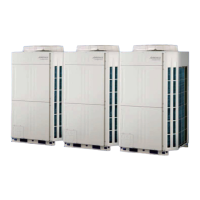
Do you have a question about the Fujitsu Airstage VR-II ARUM36TLAV and is the answer not in the manual?
| Cooling Capacity | 3.6 kW |
|---|---|
| Heating Capacity | 4.0 kW |
| Power Supply | 220-240 V |
| Refrigerant | R32 |
| Hertz (Hz) | 50Hz |
Outlines essential steps and precautions before and during unit installation and execution.
Lists critical checks for power source and unit settings before energizing the system.
Details checks for power supply, circuit breaker size, and power line wiring for outdoor units.
Covers refrigerant piping installation checks including insulation, filters, and pipe lengths.
Details piping layout for RB units and series connections.
Provides guidelines for calculating and inspecting the correct refrigerant charge amount.
Lists essential checks performed after the system has been powered on.
Verifies power supply, voltage, and breaker status for outdoor and indoor units.
Checks for error indications on outdoor and indoor units' PCBs and displays.
Continues error indication checks for RB units and PCB LED status.
Confirms installed units and their addresses match system list and design values.
Verifies transmission line connections for cooling and heating statuses.
Details checks for operational parameters in cooling and heating modes using a service tool.
Explains procedures for conducting test runs using outdoor unit PC board or remote controllers.
Guides on performing test runs via the outdoor unit's PC board push button settings.
Details test run procedures using standard wired, wireless, and simple remote controllers.
Details how test run signals are transmitted and how the system controls are managed.
Illustrates the refrigerant circuit diagram and lists all components with their functions.
Provides refrigerant circuit diagrams specific to outdoor air units, detailing components.
Lists all inputs and outputs with their details, control ranges, and related functions.
Covers compressor operation, including start/stop conditions, speed control, capacity control, and sequence operations.
Defines the conditions under which the compressor operates or stops, including protective operations.
Explains compressor speed ranges, changing intervals, and variations based on outdoor temperature.
Details compressor capacity control for stand-alone and multi-unit systems, including target pressure control.
Explains how heat exchanger capacity is controlled using 4WV, fan, and EEV based on targets.
Describes operation mode selection and controlling of heat exchangers based on system demand and conditions.
Covers fan control strategies for cooling and heating operations, including speed settings and conditions.
Explains fan speed control for cooling modes based on high-pressure saturation temperature.
Details fan speed control for heating modes, including operation ranges and intermittent fan modes.
Describes the control and operation range of Electronic Expansion Valves (EEVs) in different modes.
Explains the purpose, start/end conditions, and operation steps for oil recovery.
Outlines defrosting start and end conditions, including temperature judgment criteria.
Details various protective functions like discharge temperature, high pressure, low pressure, and compressor temperature protections.
Explains discharge temperature protection mechanisms and their controlling actions.
Covers high pressure protection functions, start conditions, release conditions, and operations.
Details low pressure protection, including start conditions, release conditions, and abnormal operations.
Outlines heatsink temperature protection measures and their operational responses.
Covers abnormal operation scenarios, error code displays, and troubleshooting procedures for various errors.
Explains the structure of error codes and how to confirm actual error conditions using service tools.
Describes error indication flashing patterns for indoor unit main PCBs and how errors are displayed.
Explains the 7-segment LED patterns and descriptions for outdoor unit displays during errors.
Provides an index of error codes, linking subsection and specific errors to their troubleshooting steps.
Continues the error code index, linking subsection and specific errors to troubleshooting.
Provides step-by-step troubleshooting procedures for specific error codes, including checks and possible causes.
Offers troubleshooting steps for issues without specific error codes, focusing on power and circuit checks.
Displays refrigerant circuit diagrams for various models, illustrating component connections.
Provides detailed wiring diagrams for various indoor unit types, including compact cassette, slim duct, and wall-mounted units.
Wiring diagrams for Compact Cassette, Slim Duct, and Wall Mounted indoor units.
Wiring diagram for outdoor units, showing connections between main PCB, filter PCB, fan driver, and other components.
Provides detailed precautions and procedures for compressor removal, including power off and refrigerant collection.











